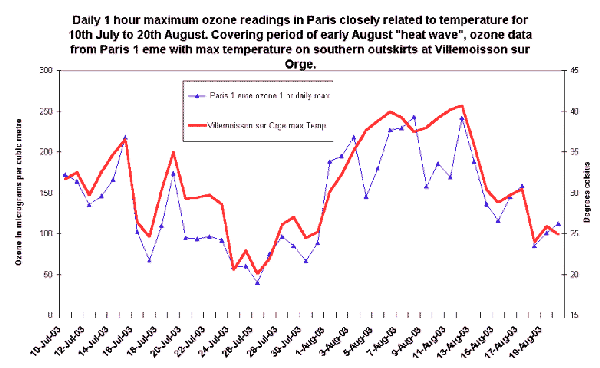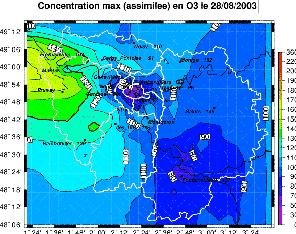
Ozone in the Paris Urban Heat Island
The Paris heat wave of early August 2003 provides an interesting opportunity
to study the close relationship between daytime temperature and ozone levels.
The graph below demonstrates that hot days are strong drivers of high ozone
levels.
Prevailing scientific wisdom from many of the national or state "EPA's" whose reports I have read, emphasizes the role of precursor pollutants in the formation of ozone, the principal one of which is nitrogen dioxide or NO2, a product of combustion. The air quality authority for the Paris region is Airparif and on their web site (linked at bottom of page) you can download certain air monitoring data and also make instructive colour contoured maps of ozone and NO2 distribution each day for the Ille de France region, follow their link top right to Modelisation.
I have downloaded a series of maps for the period 14 July 2003 to 31st August straddling the Paris heat wave and I have assembled these all on one web page where readers can easily compare side by side the distribution each day of maximum readings for nitrogen dioxide (NO2) on the left and ozone on the right (make a coffee while the 98 maps load). The first feature apparent is that the left hand maps showing nitrogen dioxide persistently show a close relationship between elevated levels of NO2 and the Paris region. Thus I would say that NO2 levels are a way of defining the Paris Urban Heat Island. Conversely, elevated ozone readings usually do not bear any close relationship to the Paris region but in fact areas of elevated ozone change distribution over Europe depending on temperature and movement of air masses. However, one feature that soon becomes apparent is that there is a geophysical feature that I have named the "Paris Ozone Hole" --
 - obvious as an area of
depressed ozone readings on most days of low or moderate ozone levels. The
existence of the Paris Ozone Hole, an area of relative ozone depletion, exactly
where NO2 is elevated, together with elevated ozone over wide areas low
in NO2 must seriously question the widely promulgated simplistic
notion that NO2 from air pollution is the significant
precursor species to ozone formation. The author prefers a scenario of
ozone formation that recognizes many ozone precursors are in fact natural, such
as volatile organic compounds released from vegetation or salt particles in sea
spray. The Paris ozone hole could be partly due to less sunlight
penetrating the Paris urban heat island with its greater air turbidity
from pollution and haze compared to rural surrounds.
- obvious as an area of
depressed ozone readings on most days of low or moderate ozone levels. The
existence of the Paris Ozone Hole, an area of relative ozone depletion, exactly
where NO2 is elevated, together with elevated ozone over wide areas low
in NO2 must seriously question the widely promulgated simplistic
notion that NO2 from air pollution is the significant
precursor species to ozone formation. The author prefers a scenario of
ozone formation that recognizes many ozone precursors are in fact natural, such
as volatile organic compounds released from vegetation or salt particles in sea
spray. The Paris ozone hole could be partly due to less sunlight
penetrating the Paris urban heat island with its greater air turbidity
from pollution and haze compared to rural surrounds.
Email to
Back to ozone front page
Back to http://www.warwickhughes.com/
Links
AIRPARIF Institution
http://www.airparif.asso.fr/donnees/default.htm
Comprehensive site re tropospheric ozone. Many reports on ozone
and air quality issues
http://www.asl-associates.com/
European Environment body, make maps of ozone distribution over most
of western Europe.
http://prevair.ineris.fr/prevision/carte/20030820/O3_CCM_PMAP_D%2B0_big.gif
Web page with Villemoisson sur Orge temperature data, follow archive
link
http://www.meteolafleche.vmeteo.cjb.net/listestationconnect.php?Delai=60&SelectStation=2002_2366325